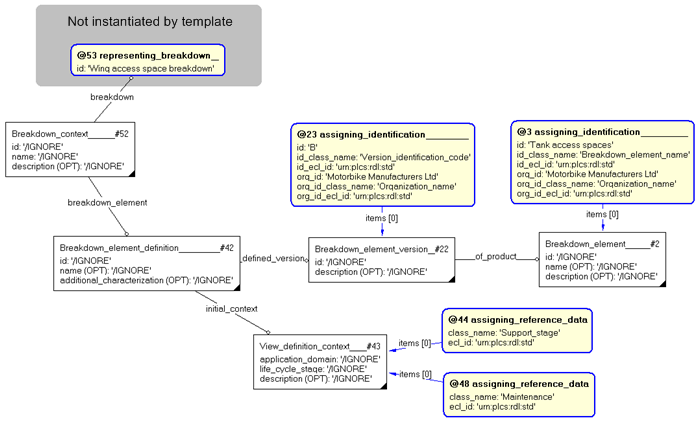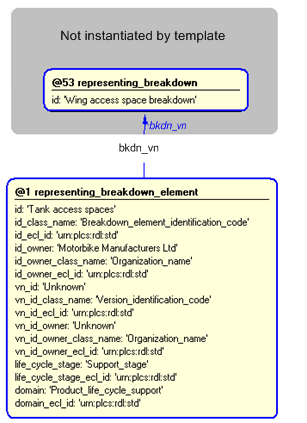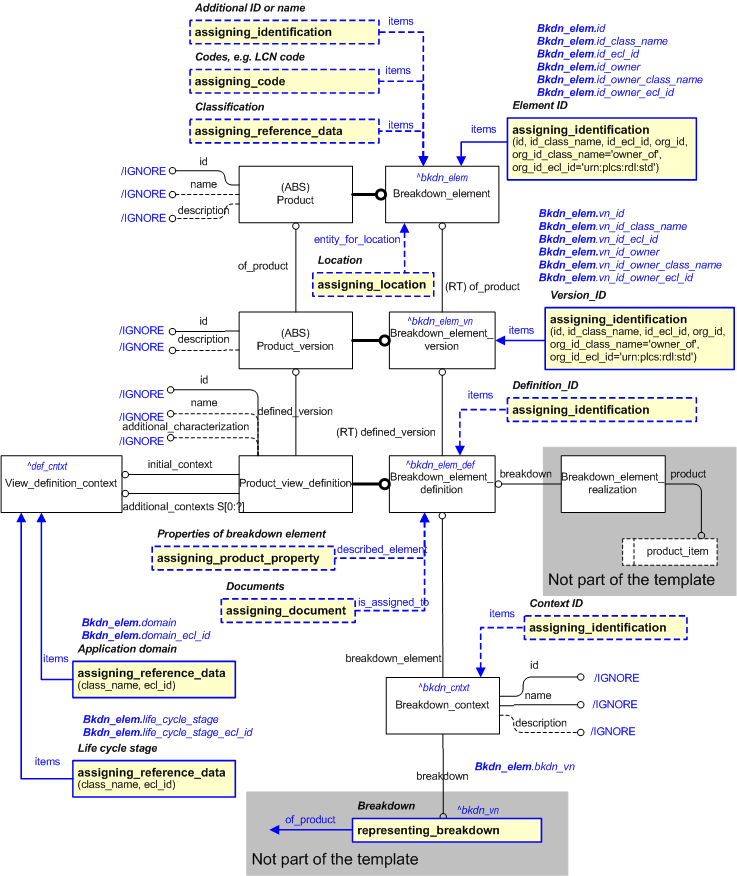| Template:— representing_breakdown_element (rep_bkdn_elem) |
Date: 2008/02/28 23:59:11
Revision: 1.16
|
This section specifies the template representing_breakdown_element.
NOTE
An explanation of a template and the associated instantiation path is
provided in the
Template overview
section.
The EXPRESS-G diagram in
Figure
1
shows the templates and EXPRESS entities that are required
to represent the template
"representing_breakdown_element".
The text highlighted in blue shows the template parameters.
Templates within grey rectangles and templates with dashed lines are not included in the template, but may be used
to further
characterize the template.
Figure 1 — An EXPRESS-G representation of the Information model for representing_breakdown_element
The graphic for the template to be used in other EXPRESS-G diagrams
is shown in Figure
2
below.
Figure 2 — The graphical representation of the representing_breakdown_element template
The following input parameters are defined for this template:
id_class_name (Default=Breakdown_element_identification_code,Type='CLASS')
The name of the class being used to classify the
(
Identification_assignment)
of the breakdown_element. This provides the role or reason for the identification.
The following classes and their sub-classes can be used:
id_ecl_id (Default=urn:plcs:rdl:std,Type='URN')
The identifier of the
External_class_library
storing the definition of the class referenced by the parameter @id_class_name class.
The name or identifier of the organization owning the id or name.
The name of the class being used to classify the
identification of the organization. For example CAGE code, or organization name.
The following classes and their sub-classes can be used:
vn_id (Default=Unknown,Type='STRING')
The name of the class being used to classify the identification
(
Identification_assignment)
of the breakdown_element_version. This provides the role or reason for the identification.
The following classes and their sub-classes can be used:
The identifier of the
External_class_library
storing the definition of the class referenced by the parameter @vn_id_class_name class.
The name or identifier of the organization owning the version_id.
The name of the class being used to classify the
identification of the organization. For example CAGE code, or organization name.
The following classes and their sub-classes can be used:
The following classes and their sub-classes can be used:
The identifier of the
External_class_library
storing the definition of the class referenced by the parameter @life_cycle_stage class.
domain (Default=Product_life_cycle_support,Type='CLASS')
The following classes and their sub-classes can be used:
The identifier of the
External_class_library
storing the definition of the class referenced by the parameter @domain class.
The following reference parameters are defined for this template:
Allow the
Breakdown_element
entity instantiated in this path to be referenced when this template is used.
%^target = $representing_breakdown_element.bkdn_elem%
%^target = $representing_breakdown_element.bkdn_elem_vn%
%^target = $representing_breakdown_element.bkdn_elem_def%
%^target = $representing_breakdown_element.def_cntxt%
Allow the
Breakdown_context
entity instantiated in this path to be referenced when this template is used.
%^target = $representing_breakdown_element.bkdn_cntxt%
The instantiation path shown below specifies the entities that are to be
instantiated by the template.
-- instantiate Breakdown_element Breakdown_element%^bkdn_elem =
Breakdown_element%
^bkdn_elem.id = '/IGNORE'
^bkdn_elem.name = '/IGNORE'
^bkdn_elem.description = '/IGNORE'
-- assign ID to breakdown_element /
assigning_identification(
id=@id,
id_class_name=@id_class_name,
id_ecl_id=@id_ecl_id,
org_id=@id_owner,
org_id_class_name=@id_owner_class_name,
org_id_ecl_id=@id_owner_ecl_id,
items=^bkdn_elem)/
-- instantiate Breakdown_element_version Breakdown_element_version%^bkdn_elem_vn =
Breakdown_element_version%
^bkdn_elem_vn.id = '/IGNORE'
^bkdn_elem_vn.description = '/IGNORE'
^bkdn_elem_vn.of_product ->
^bkdn_elem
-- assign ID to Breakdown_element_version /
assigning_identification(
id=@vn_id,
id_class_name=@vn_id_class_name,
id_ecl_id=@vn_id_ecl_id,
org_id=@vn_id_owner,
org_id_class_name=@vn_id_owner_class_name,
org_id_ecl_id=@vn_id_owner_ecl_id,
items=^bkdn_elem_vn)/
-- instantiate Breakdown_element_definition Breakdown_element_definition%^bkdn_elem_def =
Breakdown_element_definition%
^bkdn_elem_def.id = '/IGNORE'
^bkdn_elem_def.name = '/IGNORE'
^bkdn_elem_def.additional_characterization = '/IGNORE'
^bkdn_elem_def.defined_version ->
^bkdn_elem_vn
-- instantiate View_definition_context and bind it to the Breakdown_element_definition
^bkdn_elem_def.initial_context ->
View_definition_context%^def_cntxt =
View_definition_context%
^def_cntxt.life_cycle_stage = '/IGNORE'
^def_cntxt.application_domain = '/IGNORE'
^def_cntxt.description = '/IGNORE'
-- assign life_cycle_stage to the view_definition_context /
assigning_reference_data(
items=^def_cntxt,
class_name=@life_cycle_stage,
ecl_id=@life_cycle_stage_ecl_id)/
-- assign application_domain to the context /
assigning_reference_data(
items=^def_cntxt,
class_name=@domain,
ecl_id=@domain_ecl_id)/
-- instantiate Breakdown_context to connect breakdown_element_definition -- to a breakdown_version Breakdown_context%^bkdn_cntxt =
Breakdown_context%
^bkdn_cntxt.id = '/IGNORE'
^bkdn_cntxt.name = '/IGNORE'
^bkdn_cntxt.description = '/IGNORE'
^bkdn_cntxt.breakdown_element ->
^bkdn_elem_def
^bkdn_cntxt.breakdown ->
@bkdn_vn
The following entities are instantiated with attributes as specified:
The instance diagram in Figure
3
shows an example of the EXPRESS entities and templates that are instantiated by the template:
/representing_breakdown_element(id='Tank access spaces', id_class_name='Breakdown_element_name', id_ecl_id='urn:plcs:rdl:std', id_owner='Motorbike Manufacturers Ltd', id_owner_class_name='Organization_name', id_owner_ecl_id='urn:plcs:rdl:std', vn_id='B', vn_id_class_name='Version_identification_code', vn_id_ecl_id='urn:plcs:rdl:std', vn_id_owner='Motorbike Manufacturers Ltd', vn_id_owner_class_name='Organization_name', vn_id_owner_ecl_id='urn:plcs:rdl:std', life_cycle_stage='Support_stage', life_cycle_stage_ecl_id='urn:plcs:rdl:std', domain='Maintenance', domain_ecl_id='urn:plcs:rdl:std', bkdn_vn='#53')/
(an illustration of the consolidated representing_breakdown_element template is shown in
Figure
4 below.)
Note that the
assigning_reference_data and
assigning_identification templates are used in the diagram.
Namely:
/assigning_reference_data(items='#43', class_name='Maintenance', ecl_id='urn:plcs:rdl:std')/
/assigning_reference_data(items='#43', class_name='Support_stage', ecl_id='urn:plcs:rdl:std')/
/assigning_identification(items='#2', id='Tank access spaces', id_class_name='Breakdown_element_name', id_ecl_id='urn:plcs:rdl:std', org_id='Motorbike Manufacturers Ltd', org_id_class_name='Organization_name', org_id_ecl_id='urn:plcs:rdl:std')/
/assigning_identification(items='#22', id='B', id_class_name='Version_identification_code', id_ecl_id='urn:plcs:rdl:std', org_id='Motorbike Manufacturers Ltd', org_id_class_name='Organization_name', org_id_ecl_id='urn:plcs:rdl:std')/
Figure 3 — Entities instantiated by representing_breakdown_element template
The instance diagram in
Figure
4
shows the graphic symbol for the template that is to be
used in other instance diagrams. The example template is:
/representing_breakdown_element(id='Tank access spaces', id_class_name='Breakdown_element_name', id_ecl_id='urn:plcs:rdl:std', id_owner='Motorbike Manufacturers Ltd', id_owner_class_name='Organization_name', id_owner_ecl_id='urn:plcs:rdl:std', vn_id='B', vn_id_class_name='Version_identification_code', vn_id_ecl_id='urn:plcs:rdl:std', vn_id_owner='Motorbike Manufacturers Ltd', vn_id_owner_class_name='Organization_name', vn_id_owner_ecl_id='urn:plcs:rdl:std', life_cycle_stage='Support_stage', life_cycle_stage_ecl_id='urn:plcs:rdl:std', domain='Maintenance', domain_ecl_id='urn:plcs:rdl:std', bkdn_vn='#53')/
Figure 4 — Instantiation of representing_breakdown_element template
The following section details how the
representing_breakdown_element
template can be optionally characterized by assigning
other constructs to it. These are characterizations commonly
applied to the template. The ISO 10303-239 EXPRESS model may enable
other assignments to the entities instantiated by the template.
The EXPRESS-G diagram in Figure
5
shows the possible characterizations of the template
"representing_breakdown_element".
Figure 5 — The graphical representation of the representing_breakdown_element characterizations
The following characterizations may apply:
Characterization Assigning classification or code
NOTE this characterization is optional.
Characterization Assigning location
NOTE this characterization is optional.
A location can be associated to a
Breakdown_element
or a Breakdown_element_version
by using the template
assigning_location.
The location may be expressed as a global location, an address-based location, an organization-based location,
or as a location in a regional grid. See further Capability C049: assigning_location (NB Capabilities are not documented in this release of the PLCS standard)
.
The assignment of the location
(assigning_location)
may be classified.
Characterization Assigning properties and documents
NOTE this characterization is optional.
Properties and documents may be associated with a
Breakdown_element_definition.
A property is associated using template
assigning_product_property
assigned to
Breakdown_element_definition
using reference parameter "^bkdn_elem_def". The assignment of properties is further explained in capability
C076: assigning_product_properties (NB Capabilities are not documented in this release of the PLCS standard)
.
A document is associated using template
assigning_document
assigned to
Breakdown_element_definition
using reference parameter "^bkdn_elem_def". The assignment of documents is further explained in capability
C005: representing_documents (NB Capabilities are not documented in this release of the PLCS standard)
.
Characterization Assigning identification
NOTE this characterization is optional.





